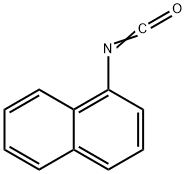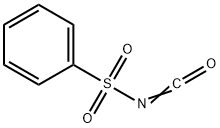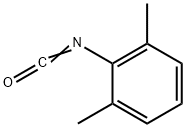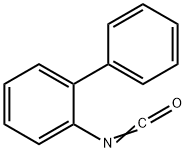1-Naphthyl isocyanate
- CAS NO.:86-84-0
- Empirical Formula: C11H7NO
- Molecular Weight: 169.18
- MDL number: MFCD00003814
- EINECS: 201-703-7
- SAFETY DATA SHEET (SDS)
- Update Date: 2025-01-27 09:38:02

What is 1-Naphthyl isocyanate?
Chemical properties
colourless or slightly yellow liquid
The Uses of 1-Naphthyl isocyanate
1-Naphthyl isocyanate is used in the preparation of cationic aromatic urethane. It is useful for the study of cholangiolitic hepatotoxicity in laboratory animals. It is also employed as separate enantiomers of beta-blockers.
Synthesis Reference(s)
Synthetic Communications, 23, p. 335, 1993 DOI: 10.1080/00397919308009785
Purification Methods
Distil the isocyanate at atmospheric pressure or in a vacuum. It can be crystallised from pet ether (b 60-70o) at low temperature. It has a pungent odour, is TOXIC and is absorbed through the skin. [Beilstein 12 H 1244, 12 III 2948.]
Properties of 1-Naphthyl isocyanate
| Melting point: | 4 °C (lit.) |
| Boiling point: | 267 °C/761 mmHg (lit.) |
| Density | 1.177 g/mL at 25 °C (lit.) |
| vapor density | 2.9 (vs air) |
| vapor pressure | 168.8 mm Hg ( 37.7 °C) |
| refractive index | n |
| Flash point: | -1 °F |
| storage temp. | Inert atmosphere,2-8°C |
| solubility | Miscible with alcohol, chloroform and diethyl ether. |
| form | clear liquid |
| color | Colorless to Light yellow to Light orange |
| Sensitive | Moisture Sensitive |
| Merck | 14,6410 |
| BRN | 742779 |
| Stability: | Stable. Incompatible with strong oxidizing agents, alcohols. |
| CAS DataBase Reference | 86-84-0(CAS DataBase Reference) |
| NIST Chemistry Reference | Naphthalene, 1-isocyanato-(86-84-0) |
| EPA Substance Registry System | 1-Isocyanatonaphthalene (86-84-0) |
Safety information for 1-Naphthyl isocyanate
| Signal word | Danger |
| Pictogram(s) |
 Exclamation Mark Irritant GHS07  Health Hazard GHS08 |
| GHS Hazard Statements |
H315:Skin corrosion/irritation H317:Sensitisation, Skin H319:Serious eye damage/eye irritation H334:Sensitisation, respiratory H335:Specific target organ toxicity, single exposure;Respiratory tract irritation |
| Precautionary Statement Codes |
P261:Avoid breathing dust/fume/gas/mist/vapours/spray. P264:Wash hands thoroughly after handling. P264:Wash skin thouroughly after handling. P280:Wear protective gloves/protective clothing/eye protection/face protection. P301+P312:IF SWALLOWED: call a POISON CENTER or doctor/physician IF you feel unwell. P305+P351+P338:IF IN EYES: Rinse cautiously with water for several minutes. Remove contact lenses, if present and easy to do. Continuerinsing. |
Computed Descriptors for 1-Naphthyl isocyanate
New Products
Indole Methyl Resin tert-butyl 9-methoxy-3-azaspiro[5.5]undecane-3-carboxylate Boc-His(Boc)-OH 2-CTC Resin 4-Chloro-7-tosy1-7Hpyrrolo[2,3-d]pyrimidine 5,7-Dibromo-1H-indole 2,5-dichloro-N-hydroxy-4,6-dimethylpyridine-3-carboximidamide 2,2-Dimethoxy-7-azaspiro[3.5]nonane hydrochloride 4-chloromethyl-5-methyl-1,3-dioxol-2-one (DMDO-Cl) R-2-BENZYLOXY PROPIONIC ACID 1,1’-CARBONYLDIIMIDAZOLE 1,1’-CARBONYLDI (1,2-4 TRIAZOLE) N-METHYL INDAZOLE-3-CARBOXYLIC ACID 4-((2-hydroxyethyl)thio)benzoic acid 1-(TERT-BUTOXYCARBONYL)-2-PYRROLIDINONE Methyl 6-methylnicotinate 3-Pyridineacrylic acid tert-Butyl carbazate TETRAHYDRO-2H-PYRAN-3-OL 2-((4-morpholinophenylamino) (methylthio) methylene) malononitrile 3-(4-morpholinophenylamino)-5-amino-1H-pyrazole-4-carbonitrile 2,4-dihydroxybenzaldehyde 1,3-Diethyl-1,3-Diphenylurea Methyl 2-methylquinoline-6-carboxylateRelated products of tetrahydrofuran








You may like
-
 1-Naphthyl Isocyanate CAS 86-84-0View Details
1-Naphthyl Isocyanate CAS 86-84-0View Details
86-84-0 -
 1-Naphthyl isocyanate CAS 86-84-0View Details
1-Naphthyl isocyanate CAS 86-84-0View Details
86-84-0 -
 1- NaphthylisocyanateView Details
1- NaphthylisocyanateView Details
86-84-0 -
 Pyridine 99.5% HPLC /UV SpectroscopyView Details
Pyridine 99.5% HPLC /UV SpectroscopyView Details
110-86-1 -
 Piperazine Spot supply, best priceView Details
Piperazine Spot supply, best priceView Details
110-85-0 -
 Dibutyl PhthalateView Details
Dibutyl PhthalateView Details
84-74-2 -
 Imidazole Spot supply, competitive priceView Details
Imidazole Spot supply, competitive priceView Details
288-32-4 -
 Thiourea 99% ARView Details
Thiourea 99% ARView Details
62-56-6
Statement: All products displayed on this website are only used for non medical purposes such as industrial applications or scientific research, and cannot be used for clinical diagnosis or treatment of humans or animals. They are not medicinal or edible.
